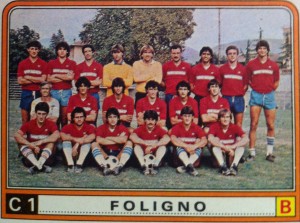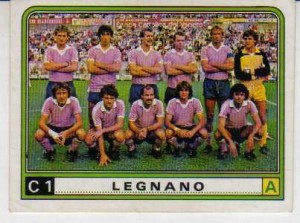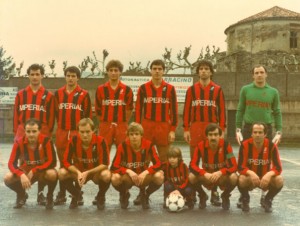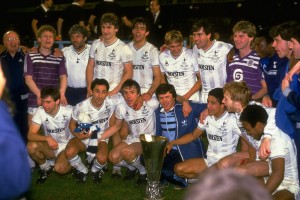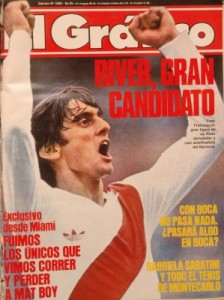Serie A. Was it really the top championship of Europe? Hard to measure – on one hand, Italy was the reigning World Champion. The best players of the world were moving to play in Italy. At least two clubs were just wonderfully strong – Roma and especially Juventus. Traditionally, Serie A was one of the toughest league in the world. On the other hand – despite the foreign talent, there were outsiders, one particularly weak this season. A whole bunch of clubs were either shaky (Milan, Torino, Inter), or painfully trying to rebuild (Lazio), or just stuck and unable to improve (Fiorentina, Sampdoria). Only 2 teams competed for the title, leaving the rest of the league far behind. Scoring was still low and the tie still ruled – only 5 teams finished with less than 10 ties after 30 games played. Only the champions scored more than 50 goals – no other team reached the mark – and even they were unable to achieve an average of 2 goals per game. The only really positive thing was largely unnoticed: the improvement of Hellas Verona – or simply Verona at that time.

Catania was hopeless – they won one match during the whole season. They lost 14 out of 15 away games. They scored less than half-a-goal per game: 14 goals. Absolute outsiders, ending with 12 points.
Standing from left: Ranieri, Sorrentino, Fortunato, Mosti, Cantarutti, Pedrinho. First row: Giovannelli, Luvanor, Morra, Mastalli, Crialesi.

Pisa was 15th with 22 points. Not as weak as Catania, but still very weak.

Genoa ended 14th with 25 points.

Lazio managed to escape the relegation zone only on better goal-difference than Genoa’s – 25 points and 13th place. Perhaps that was enough for the moment – securing the next season. Things were shaky and controvercial at the club, which suffered tremedous decline and relegation to Serie B. Rebuilding? There were players suggesting a core at least: Giordano, Manfredonia, D’Amico and the bright very young Dane Michael Laudrup. Giorgio Chinaglia was back from New York and a president. There was light at the end of the tunel… on paper. Chinaglia’s reign was not exactly enjoyed by the fans.

Napoli finished 12th with 26 points. Classy foreigners were not enough to propel the club higher – looked like Napoli was going in the opposite direction: down. Barely escaping relegation, that was the reality.
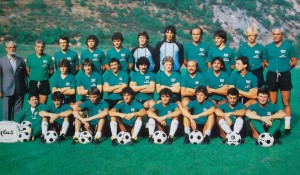
Avellino – 11th with 26 points. Not a bad season for them – after all, Avellino traditionally aimed only to avoid relegation and succeeding in that equaled good season.
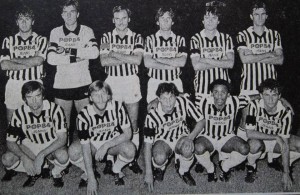
Ascoli – a club like Avellino, so 10th place with 29 points was fine.

Udinese – 9th with 31 points. Not bad. Also a point in case: Italian clubs ruled the world – a relatively lowly club like Udinese had Zico in the squad. True, even with him the best was mid-table position, but attracting players of such class and reputation? That was Italy at this time and no matter who grumbled about the travesty of wasted talent, great players had no second thought in chosing smaller Italian sides than big names paying pittance. Mind, it was not just Zico here – there was one more Brazilian national team star – Edinho, there was the aging Juventus’ star Causio, there was bright and talented De Agostini. Not a bad team, in fact – thus, giving weight to the argument that the top football was played in Italy: such a team managed only mid-table position, so imagine what kind of teams other clubs had! Imagination is one thing, reality – quite another: Italian clubs were spending money around, that was all.

Milan finished 8th with 32 points. Not a great season at all – rather shaky, in fact. But the club was trying to resurface from its own disasters, so this was a time for rebuilding and titles were not a goal. A major point was cleaning the club’s image and that was partly going against rebuilding: Eric Gerets was just bought and soon after that the Belgian bribing scandal hit the news. Gerets was involved… and Milan let him go. Not a great move in terms of rebuilding.
Front row from left: Piotti, Gerets, Baresi, Castagner – coach, Farina (?) – chairman, Galbiati – assistant coach, Battistini, Blissett, Nuciari.
Middle row: Ribolzi – masseur, Carotti, Tacconi, Mendo (?), Incocciati, Facchini – conditioning coahc, Evani, Icardi, Vallori (?), Damiani, Mariconti.
Top row: Verza, Russo, Paciocco, Galli, Tassotti, Spinosi, D’Este, Manzo, Di Marco (?), Mariani.

Sampdoria – 7th with 32 points. Should have been better, but was not. On the other hand – Sampdoria was not traditional powerhouse, so all looked like climbing up and establishing itself as a strong club. Take it as you like.

Verona was a bit neglected – they finished 6th, which was fantastic achievement for the club, but it was seen as one-time wonder. First, the final position was not particularly impressive in terms of numbers: Verona finished withj 32 points, like Milan and Sampdoria, and was above them only on better goal-difference. It was more a result of the weakness of others than anything. The foreign stars at the moment were great names – Joe Jordan and Wladislaw Zmuda – but they were aging dangerously and it was impossible to consider them as a big asset for the future. The rest of the players were not yet stars, not even very promissing. Verona was on the right track, though, and really improving.

![]()
Torino – 5th with 33 points. Torino was holding up, but decline was noticed already – the number of strong players was diminishing and the club was unable to get big talent. The golden period ended and it was highly unlikely to be repeated.

Inter – 4th with 35 points. New coach – Radice, new foreign star – the Belgian Ludo Coeck, not a bad squad at all, but somewhat still in a building process, still unfinished, looking more to the future than to the present (Bordon was aging, but Zenga was still too young). Hansi Muller, Baresi, Collovati, Altobelli, Oriali, Gori, Ferri, Bini, Serena, Marini, Bagni… if names tell enough, Inter should have been title contender. The fact that it was not suggests only one thing: unfinished product.
Front row from left: Raveggi – masseur, Bortolazzi, A. Bertoni, Carobbi, Passarella, Merendi (?), Cecarini (?), F. Rossi, Graniti – masseur.
Middle row: Massaro, Pecci, Ferroni, Onesti – assistant coach, De Sisti – coach, Secci (?) – assistant coach, Costagliola, Oriali, Sala.
Standing: Morichi – administrator, Landucci, Cuccureddu, D. Bertoni, Antognoni, Pin, Galli, Iachini, Miani, Pulici, Monelli, Alessandrelli, Baccani – doctor.

Fiorentina – 3rd with 36 points. Nice squad, perhaps at its peak, but also there was something else: a good squad Fiorentina was able to build a great one – no. Thus, bronze was the most this vintage could get – not a title contender, somewhat too limited for that.

Roma was at its best and run for the title from start to end of the season, but failed to win and make it two in a row. Perhaps trying to win three tournaments in one season took its tall, but still one cannot be critical of this team – they did their best, but faced very strong rival.

It was boring for many, but it was Juventus once again. Giovanni Trapattoni shaped its squad perfectly – Platini and Boniek adjusted to each other and their highly talented teammates, everything clicked right. As every great team in history, the key players were not many – practically 14 players were used in the championship, suggesting great form of the regulars and well oiled squad, delivering weak after weak. Veterans were effectively replaced by current talent – Furino appeared only once this season. Juventus proved its worth in a battle against equally strong Roma, having advantage for the future, for it was younger team. The team was ready, there was no need of new key players to fill any gaps. Juventus was also successful internationaly, so there was no doubt – this was a team to shape Europeam football in the following years. The strongest in Italy? For sure.






















